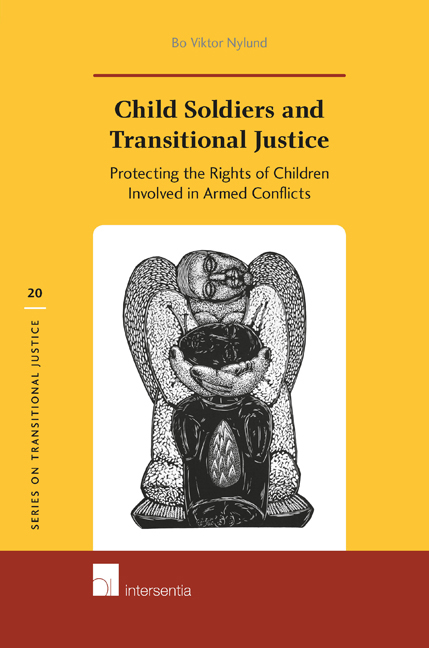 Child Soldiers and Transitional Justice
Child Soldiers and Transitional Justice Book contents
- Frontmatter
- Acknowledgements
- About the Author
- Contents
- List of Abbreviations
- Chapter 1 Objective, Scope, and Transitional Justice as an Analytical Framework
- Chapter 2 Child Recruitment and the Rule of Law: International Law and the Prohibition against Recruiting and Using Children to Take Direct Part in Hostilities
- Chapter 3 Child Recruitment and Criminal Justice: the Lubanga Case
- Chapter 4 Child Recruitment and Historical Justice: the Security Council Mechanism on Monitoring and Reporting
- Chapter 5 Child Recruitment and Reparatory Justice: Recovery and Reintegration of War-Affected Children
- Chapter 6 Child Recruitment and Institutional Justice
- Chapter 7 Children Involved in Armed Conflict and Participatory Justice: Balancing Rights and Responsibilities
- Chapter 8 Conclusions: Transitional Justice and the Potential for Stronger Protection of the Rights of Children Involved in Armed Conflicts
- Annexes
- Bibliography
Chapter 2 - Child Recruitment and the Rule of Law: International Law and the Prohibition against Recruiting and Using Children to Take Direct Part in Hostilities
Published online by Cambridge University Press: 12 December 2017
- Frontmatter
- Acknowledgements
- About the Author
- Contents
- List of Abbreviations
- Chapter 1 Objective, Scope, and Transitional Justice as an Analytical Framework
- Chapter 2 Child Recruitment and the Rule of Law: International Law and the Prohibition against Recruiting and Using Children to Take Direct Part in Hostilities
- Chapter 3 Child Recruitment and Criminal Justice: the Lubanga Case
- Chapter 4 Child Recruitment and Historical Justice: the Security Council Mechanism on Monitoring and Reporting
- Chapter 5 Child Recruitment and Reparatory Justice: Recovery and Reintegration of War-Affected Children
- Chapter 6 Child Recruitment and Institutional Justice
- Chapter 7 Children Involved in Armed Conflict and Participatory Justice: Balancing Rights and Responsibilities
- Chapter 8 Conclusions: Transitional Justice and the Potential for Stronger Protection of the Rights of Children Involved in Armed Conflicts
- Annexes
- Bibliography
Summary
I asked: “What were your duties as a child soldier in the movement?”
He said: “I led some of the boys in the armed group who prepared tea and food, washed the cars, and carried our belongings.”
I asked him: “What happened if those boys did not do what you told them to?”
He replied: “You hit him with the Kalashnikov.”
I asked him: “Would the commander do the same to you if he found out?”
He replied: “Nobody asks and nobody would report on you. You hit him so hard that the others will not be impolite again.”
I asked him: “If somebody older than you, like a commander, ordered you to do something you do not like, what do you do?”
He replied: “If he is a senior commander, I will obey him; but if he is an ordinary person, I hold a Kalashnikov and he holds a Kalashnikov and the one who fires first will defeat the other.”
INTRODUCTION
The rule of law implies that there is a high predictability as to how known rules will be applied, as opposed to arbitrary action by government or non-state actors. The situations where child recruitment and use take place are inherently unstable, however, underscoring the considerable need to promote the overall elements of the rule of law in order to strengthen this aspect of transitional justice. This can present both challenges and opportunities, as there is scope to introduce new ways of looking at the issues.
One great challenge is to determine what law prevails in a situation where there could be several options. In this regard, both ex post facto legislation and differences in application of the law due to the nature of the conflict or the actor involved in carrying out the violation must be taken into consideration – recognizing that the law of a previous regime may have shortcomings or there may be no law in place on the issue of concern.
Chapter 2 considers the circumstances of the child's participation during a conflict and extends the focus to encompass the end result for the child, as well as the aim of prohibiting and redressing the act itself – regardless of the situation on the ground.
- Type
- Chapter
- Information
- Child Soldiers and Transitional JusticeProtecting the Rights of Children Involved in Armed Conflicts, pp. 33 - 68Publisher: IntersentiaPrint publication year: 2016


